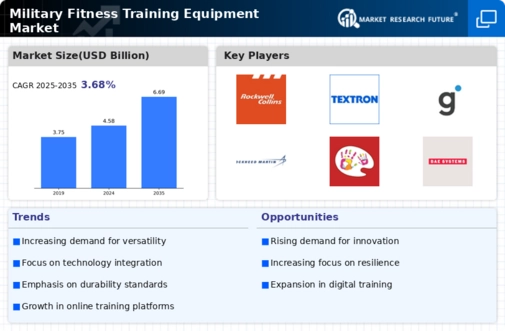The Military Fitness Training Equipment Market is currently characterized by a dynamic competitive landscape, driven by a confluence of innovation, technological advancements, and strategic partnerships. Key players such as Rogue Fitness (US), TRX Training (US), and Nautilus (US) are at the forefront, each adopting distinct operational focuses that shape the market's trajectory. Rogue Fitness (US) emphasizes product innovation and customization, catering to the specific needs of military personnel, while TRX Training (US) leverages its expertise in suspension training to enhance functional fitness training for armed forces. Nautilus (US), on the other hand, is concentrating on integrating smart technology into its equipment, thereby appealing to a tech-savvy military demographic. Collectively, these strategies foster a competitive environment that prioritizes adaptability and responsiveness to the evolving demands of military fitness training.
In terms of business tactics, companies are increasingly localizing manufacturing to mitigate supply chain disruptions and enhance responsiveness to market needs. This approach is particularly relevant in a moderately fragmented market where multiple players vie for market share. The competitive structure is influenced by the collective actions of these key players, who are not only optimizing their supply chains but also exploring regional expansions to tap into emerging markets. Such strategies are likely to enhance their operational efficiencies and market presence.
In August 2025, Rogue Fitness (US) launched a new line of tactical fitness equipment designed specifically for military training programs. This strategic move underscores the company's commitment to innovation and its understanding of the unique requirements of military personnel. By focusing on high-quality, durable products that withstand rigorous training, Rogue Fitness (US) positions itself as a leader in the niche of military fitness training equipment, potentially increasing its market share.
In September 2025, TRX Training (US) announced a partnership with the U.S. Army to develop specialized training programs that incorporate their suspension training systems. This collaboration not only enhances TRX's credibility within the military sector but also allows for the co-creation of tailored fitness solutions that meet the specific needs of soldiers. Such strategic alliances are indicative of a broader trend where companies seek to align their offerings with the operational requirements of military organizations.
In July 2025, Nautilus (US) unveiled a new smart fitness platform that integrates AI-driven analytics to track performance metrics for military personnel. This innovation reflects a growing trend towards digitalization in the fitness equipment sector, where data-driven insights are becoming essential for optimizing training outcomes. By investing in technology that enhances user experience and performance tracking, Nautilus (US) is likely to attract a more tech-oriented military clientele, thereby differentiating itself in a competitive market.
As of October 2025, the Military Fitness Training Equipment Market is witnessing a shift towards digitalization, sustainability, and AI integration, which are defining the competitive trends. Strategic alliances, such as those between equipment manufacturers and military organizations, are shaping the landscape by fostering innovation and tailored solutions. Looking ahead, competitive differentiation is expected to evolve from traditional price-based competition to a focus on innovation, technology integration, and supply chain reliability, as companies strive to meet the increasingly sophisticated demands of military fitness training.


















Leave a Comment